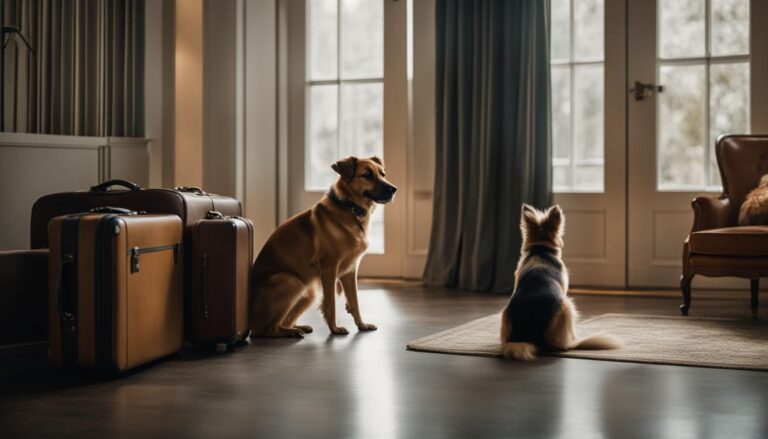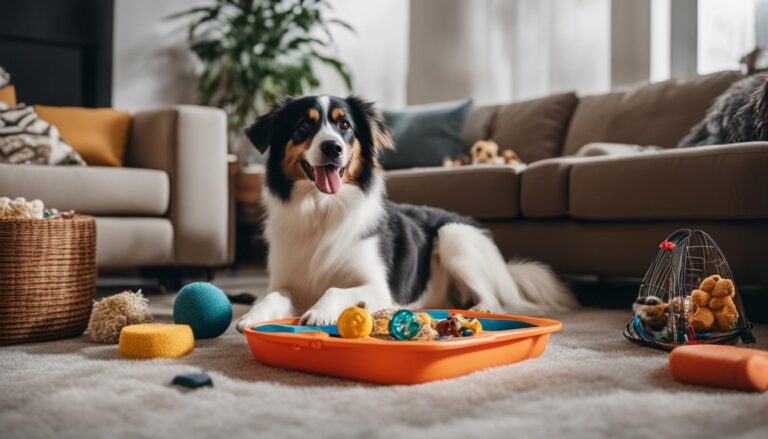When it comes to caring for our beloved pets while we’re away, dog boarding and hiring a dog sitter are two common options. But which one is best for your furry friend? In this article, I’ll explore the pros and cons of each choice and provide factors to consider when deciding between dog boarding and a dog sitter.
Key Takeaways:
- Dog boarding and hiring a dog sitter are popular options for pet owners when they’re away from home.
- Choosing between dog boarding and a dog sitter should be based on factors such as your dog’s temperament, length of time you’ll be away, personal preferences, and budget.
- Dog boarding provides socialization opportunities, a consistent routine, and a structured environment for your dog.
- A dog sitter offers personalized care, the comfort of home, and a flexible schedule.
- Consider both the benefits and drawbacks of each option to make an informed choice that ensures your pet’s well-being.
What is Dog Boarding and What to Look for in a Facility?
Dog boarding is a convenient service that allows pets to stay at a boarding facility while their owners are away. But what exactly does dog boarding entail, and what should you look for in a facility? Let’s explore.
A good dog boarding facility should prioritize the safety and comfort of your furry friend. Trained professionals should be on staff to ensure the well-being of the dogs in their care. This includes providing proper supervision, as well as having the knowledge and skills to handle any situations that may arise. It’s a good idea to inquire about the staff’s training and qualifications to ensure your pet is in capable hands.
In addition to trained professionals, a reputable dog boarding facility should provide a safe and comfortable environment for the dogs. This includes amenities such as spacious indoor and outdoor play areas, as well as enrichment activities to keep the dogs mentally stimulated. It’s important to inquire about the facility’s cleanliness, security measures, and any specific playgroups or vaccination requirements they may have.
What to Look for in a Dog Boarding Facility:
- Trained professionals on staff
- Safe and comfortable environment
- Amenities like indoor and outdoor play areas
- Enrichment activities to keep dogs mentally stimulated
- Cleanliness and security measures
- Specific playgroups and vaccination requirements
By choosing a well-equipped dog boarding facility, you can ensure that your furry friend will have a safe and enjoyable stay while you’re away.
| Factors to Consider | Dog Boarding | Dog Sitter |
|---|---|---|
| Environment | Safe and comfortable facility | Familiar home environment |
| Professional Care | Trained professionals on staff | Personalized care from a sitter |
| Socialization | Opportunities to interact with other dogs | Limited social interaction |
| Routine | Structured feeding, exercise, and playtime | Flexible schedule tailored to the dog’s needs |
The Benefits of Dog Boarding
Dog boarding offers several advantages for your furry friend, providing a structured environment and numerous opportunities for socialization. Here are some key benefits to consider:
- Socialization opportunities: Dog boarding facilities often have playgroups and scheduled activities where dogs can interact with others. This helps them develop social skills and build confidence in a supervised setting.
- Consistent routine: Boarding facilities follow a structured daily schedule, including regular feeding times, exercise, and playtime. This consistency can be comforting for dogs and helps maintain their overall well-being.
- Structured environment: Professional dog boarding facilities provide a safe and secure environment where trained staff members monitor the dogs’ behavior and ensure their safety. This structured setting can alleviate anxiety and help dogs feel more secure during their stay.
By choosing dog boarding, you can give your pet the opportunity to socialize with other dogs, maintain a consistent routine, and benefit from a structured environment. These benefits contribute to your dog’s overall happiness and well-being.
Now let’s take a closer look at the drawbacks of dog boarding.
Drawbacks of Dog Boarding
While dog boarding can be a convenient option for pet owners, it is important to acknowledge that there are some drawbacks to consider. For some dogs, being in a new environment can cause anxiety and stress. The unfamiliar surroundings and being surrounded by other dogs may take some time for them to adjust to.
Individual dogs have different temperaments and personalities, and some may struggle more than others in a boarding setting. It is essential to understand your dog’s comfort level with new environments and socialization before deciding on boarding. If your dog is particularly anxious or has difficulty adapting to change, it may be worth exploring alternatives such as a dog sitter.
When dogs are boarded, they also lose the comforts and familiarities of their own home. This change in environment can be challenging for them, especially if they have specific routines or are easily stressed by new surroundings. Owners should consider their dog’s individual adjustment needs and assess whether they would be more comfortable in the familiar environment of their own home under the care of a dog sitter.
| Drawbacks of Dog Boarding | Considerations |
|---|---|
| Anxiety and Stress | Assess your dog’s temperament and comfort level with new environments. |
| Loss of Familiar Environment | Consider whether your dog would be more comfortable in their own home. |
| Individual Adjustment Needs | Take into account your dog’s specific needs and ability to adapt to change. |
While dog boarding can be a suitable option for many dogs, it is crucial to consider the potential drawbacks and determine what is best for your furry friend’s well-being and happiness. Communication with the boarding facility, asking about their individual adjustment strategies, and even taking advantage of free daycare options can help ease the transition and make the experience as positive as possible for your beloved pet.
What is a Dog Sitter?
A dog sitter is someone who provides home care for dogs while their owners are away. Whether it’s a professional pet sitter or a trusted friend or family member, a dog sitter offers a personalized and familiar environment for the pet. This option allows dogs to stay in the comfort of their own home, which can be especially beneficial for pets with specific needs or those who are more comfortable in familiar surroundings.
When hiring a dog sitter, it’s important to consider the specific requirements of the pet. Whether it’s administering medication, following a specific feeding routine, or providing extra attention and exercise, a dog sitter can tailor their care to meet these individual needs. This personalized approach ensures that the dog’s well-being and comfort are prioritized during the owner’s absence.
While a dog sitter offers many advantages, it’s essential to choose a reliable and trustworthy individual or service. Researching and interviewing potential dog sitters, checking references, and discussing expectations and responsibilities are crucial steps in finding the right fit. Additionally, discussing any specific concerns or requirements with the dog sitter beforehand will help ensure a smooth and worry-free experience for both the owner and their furry friend.
“A dog sitter provides personalized care in the comfort of the pet’s own home.”
Table: Comparison of Dog Boarding and Dog Sitting
| Factors | Dog Boarding | Dog Sitting |
|---|---|---|
| Environment | Stay at a boarding facility | Remain in the comfort of their own home |
| Personalized Care | May have structured routines | Can have tailored care based on specific needs |
| Security | 24/7 supervision at a facility | Stranger access to the home raises security concerns |
| Social Interaction | Opportunities to socialize with other dogs | Limited social interaction, unless arranged with the sitter |
| Cost | Can vary based on facility and services | Can be more affordable, especially with trusted friends or family members |
Choosing between dog boarding and dog sitting ultimately depends on the dog’s individual needs, the owner’s preferences, and other factors such as the length of time away and budget considerations. Both options offer their own benefits and drawbacks, and it’s important for owners to carefully weigh these factors before making a decision. Ultimately, the well-being and comfort of the pet should be the top priority, ensuring a positive experience for both the dog and their owner.
Benefits of Hiring a Dog Sitter
When it comes to taking care of our furry friends while we’re away, hiring a dog sitter can offer several benefits. One of the main advantages of hiring a dog sitter is the personalized care that they provide. Unlike a boarding facility where multiple dogs are cared for, a dog sitter can focus solely on your pet’s needs and routines. They can cater to dietary restrictions, provide medication if necessary, and ensure that your dog feels comfortable and secure in their own home.
Another benefit of hiring a dog sitter is that your dog gets to stay in the comfort of their own home. Dogs are creatures of habit and thrive on familiarity. Being in a familiar environment reduces stress and anxiety, ensuring that your pet feels safe and secure while you’re away. Plus, they don’t have to adjust to a new physical space or interact with unfamiliar dogs, which can be a relief for more introverted or anxious pets.
Flexibility is yet another advantage of hiring a dog sitter. Unlike a boarding facility that may have set drop-off and pick-up times, a dog sitter can work on a schedule that suits you and your pet. Whether you need someone to pop in a few times a day or stay overnight, a dog sitter can accommodate your needs. This flexibility is particularly beneficial if your dog has specific routines or requires extra attention due to medical conditions or behavioral issues.
Quotes from Satisfied Dog Owners:
“I love hiring a dog sitter because I know that my dog is getting one-on-one attention and care. It’s like having a personal assistant for my pup!” – Sarah M.
“The best thing about a dog sitter is that my dog gets to stay in the comfort of his own home. He’s less stressed and happier when I return!” – Mike P.
“I appreciate the flexibility that a dog sitter offers. They can cater to my dog’s specific needs and routines, which gives me peace of mind while I’m away.” – Emily T.
Overall, hiring a dog sitter provides personalized care, the comfort of home, and a flexible schedule for both you and your furry friend. It’s a great option for pet owners who want their dogs to be well taken care of in a familiar and stress-free environment.
| Benefits of Hiring a Dog Sitter |
|---|
| Personalized care tailored to your pet’s needs |
| Reduced stress and anxiety by staying in the comfort of home |
| Flexibility in scheduling and routines |
Drawbacks of Hiring a Dog Sitter
While hiring a dog sitter can be a convenient option for pet owners, there are some drawbacks to consider. One of the main concerns is the inconsistent quality of care that dog sitters may provide. Since each sitter is an individual, their expertise and reliability can vary. It’s essential to thoroughly vet potential sitters and check their references to ensure that they have the necessary experience and can be trusted with the well-being of your furry friend.
Another factor to consider is security concerns. Allowing a stranger into your home raises potential risks and may leave you feeling uneasy about leaving your belongings and property unattended. It’s important to choose a dog sitter through reputable channels and take precautions such as installing security cameras or using a trusted sitter agency to mitigate these concerns.
Additionally, hiring a dog sitter may result in limited social interaction for your pet. Unlike in a boarding facility where dogs can interact with other pets, being at home with a sitter may limit their opportunities for socialization. If socialization is an important aspect for your dog’s well-being, consider alternative options such as dog daycare or playdates with other dogs.
Table: Comparison of Dog Boarding and Dog Sitting
| Dog Boarding | Dog Sitting | |
|---|---|---|
| Quality of Care | Consistent, provided by trained professionals | Inconsistent, varying expertise and reliability |
| Security | Secure facility, minimal security concerns | Stranger in the home, potential security risks |
| Social Interaction | Opportunities to interact with other dogs | Limited socialization |
Table: A comparison between dog boarding and dog sitting based on quality of care, security, and social interaction.
Ultimately, the decision between dog boarding and hiring a dog sitter depends on your personal preferences and the specific needs of your pet. Consider the individual temperament of your dog, the length of time you will be away, and your budget when making this choice. By carefully evaluating the pros and cons of each option, you can make an informed decision that prioritizes the well-being and happiness of your furry friend.
Factors to Consider When Choosing Between Dog Boarding and a Dog Sitter
When deciding whether to opt for dog boarding or a dog sitter, several factors should be taken into consideration. These factors include your dog’s temperament, the length of time you will be away, your personal preferences, and your budget. Each option has its own advantages and disadvantages, and by evaluating these factors, you can make an informed decision that is best for your furry friend.
Temperament: Dogs have different temperaments, and it is important to consider how they will adapt to different environments. Some dogs thrive in a structured boarding facility, where they have the opportunity to socialize with other dogs and follow a consistent routine. On the other hand, dogs that are more anxious or easily stressed may feel more comfortable staying in their own familiar environment with a dog sitter.
Length of Time: The duration of your absence is another crucial factor to consider. If you will only be away for a short period of time, such as a weekend trip, hiring a dog sitter may be the more practical option. However, if your absence will be longer, such as a vacation or business trip, dog boarding might provide a more suitable solution, as boarding facilities are equipped to cater to the needs of dogs over extended periods.
Personal Preferences and Budget: Your personal preferences and financial considerations also play a role in the decision-making process. Some owners may have a strong preference for their dog to stay in a familiar home environment and receive individualized care from a dog sitter. Others may prioritize the socialization opportunities and amenities offered by boarding facilities. Additionally, it’s important to assess your budget and determine what option aligns best with your financial resources.
| Factors to Consider | Dog Boarding | Dog Sitter |
|---|---|---|
| Temperament | Opportunity for socialization with other dogs | Familiar environment, reduced stress |
| Length of Time | Well-equipped for longer absences | Practical for shorter periods |
| Personal Preferences | Structured environment, amenities | Individualized care, comfort of home |
| Budget | Costs may vary based on facility and services | Costs may vary based on location and services |
Ultimately, the decision between dog boarding and a dog sitter should prioritize your pet’s well-being and cater to their specific needs. Take the time to evaluate these factors and consider what will provide the most comfortable and secure experience for your furry friend during your absence.
Conclusion
After weighing the advantages and disadvantages of dog boarding and a dog sitter, it is clear that choosing the best option ultimately depends on your furry friend’s needs and your personal preferences. It is important to consider factors such as your dog’s temperament, the length of time you will be away, and your budget.
Dog boarding offers socialization opportunities and a structured environment, ensuring your pet’s well-being. However, some dogs may struggle with the new environment and experience anxiety or stress. In such cases, it is crucial to familiarize your dog with the facility beforehand and take advantage of free daycare to ease the adjustment process.
On the other hand, hiring a dog sitter provides personalized care in the comfort of your dog’s own home, catering to their specific needs. However, the quality of care may vary depending on the sitter, and security concerns may arise when allowing a stranger into your home. Additionally, your dog may miss out on social interaction that they would have in a boarding facility.
Ultimately, the well-being of your pet should be the top priority when making this decision. By considering all the factors and understanding your dog’s individual requirements, you can make an informed choice that ensures your furry friend is taken care of while you’re away.
FAQ
Is dog boarding a good option for my furry friend?
Dog boarding can be a great option for dogs, as it provides socialization opportunities, a consistent routine, and a structured environment. However, some dogs may not do well in a new environment or may experience anxiety or stress.
What is dog boarding and what should I look for in a facility?
Dog boarding is a service where pets stay at a facility while their owners are away. When choosing a boarding facility, it is important to look for trained professionals, a safe and comfortable environment, and amenities such as play areas and enrichment activities.
What are the benefits of dog boarding?
Dog boarding offers benefits such as socialization opportunities, a consistent routine for feeding and exercise, and a structured environment that can be comforting for pets.
What are the drawbacks of dog boarding?
Some dogs may not do well in a new environment or may experience anxiety or stress. It is important for owners to familiarize their dogs with the facility and take advantage of free daycare to ease the adjustment process.
What is a dog sitter?
A dog sitter is someone who comes to the owner’s home to take care of their dog while they are away. This can be a professional pet sitter or a trusted friend or family member.
What are the benefits of hiring a dog sitter?
Hiring a dog sitter allows the dog to stay in their own familiar environment and can cater to their specific needs. It provides personalized care, reduces stress, and offers flexibility in terms of scheduling.
What are the drawbacks of hiring a dog sitter?
Hiring a dog sitter can come with drawbacks such as inconsistent quality of care, security concerns of allowing a stranger into the home, and potential limited social interaction for the dog.
What factors should I consider when choosing between dog boarding and a dog sitter?
Factors to consider include the dog’s temperament and specific needs, the length of time the owner will be away, personal preferences, and budget.
How do I choose the best option between dog boarding and a dog sitter?
The best option should be chosen based on the individual dog’s needs and the owner’s preferences. By weighing the advantages and disadvantages of each option and considering factors such as temperament, length of time away, and budget, pet owners can make an informed choice that ensures their furry friend’s well-being.









